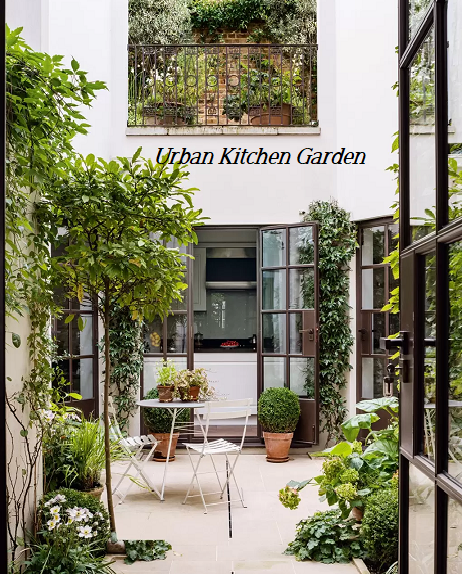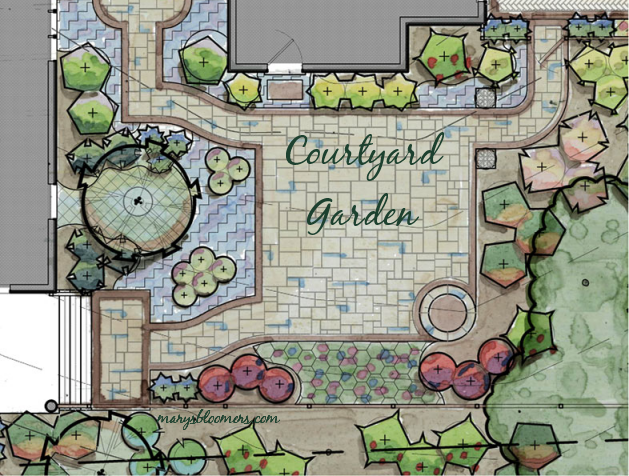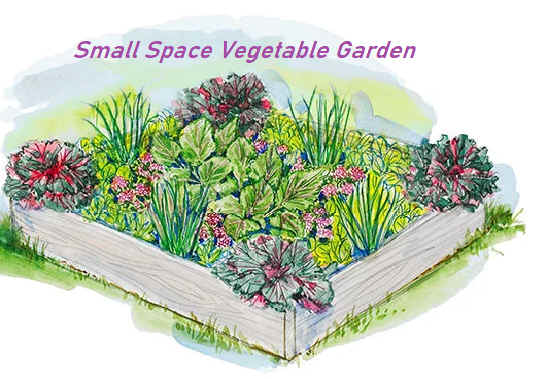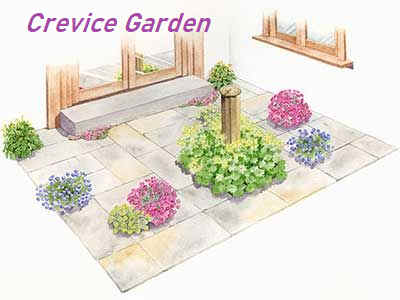Urban And Small Space Gardens

My very favorite small space garden... I spotted this one in Home and Garden Magaizne |
| Making a garden in teeny places is a great
concept. My immigrant family members and many others have done the same thing in the 50's and 60's. If there
was a spot with sunlight peeking in, stick a plant under it. Today, we can use
grow
bulbs.... i have many. And we can grow food without the sun. We can grow food
in nothing but water. We can grow on roofs, and there are cities who plant
rooftop gardens on the tops of mass transit buses. The plants ride around all
day on lots of unused space. Keeps the bus cooler, too. A garden can grow in
just about any size space anywhere, with a lot of ingenuity and creativity, and hard work. But
it can be done.
You can garden on terraces, courtyards, balconies.....and in your closets, under lights (take all your clothes out first. I defy you to find another place for them.) There are a multitude of small garden and container designs available. Find one that wows you. If you have to re-configure your idea and eliminate a planting to fit a teeny space, Just Go For It. If you need permissions to grow things, get it, if you can. Most balconies and terraces are fair game for a gardener. You don't usually need permission, but it's nice to ask anyway. After all, aesthetics are pretty important to landlords. |
 |
 |
| Apartment-dwelling farmers and
flower gardeners
abound. If you have access and permission to use a courtyard, side alley, balcony, or terrace. Some apartment and condo complexes actually have teeny spots of ground a renter may use. I've seen beautiful "secret" gardens in NYC and Charleston, S.C. The main difference being that the courtyard garden was always a custom. Built in the spaces between homes, which were very close together. Meant to be cool and a respite from the hot, muggy weather. NYC gardens sprung up because a gardener needs to garden, needed a place to hand with a friend or two, and needed something to look at besides grey skies, skyscrapers and vintage air-conditioners. A spot of country to escape to, and a way to grow your own food in pots. A bistro table, a chair, windchimes, and big container plants and wall trellises are what you need. A pseudo escape to the country and simpler living, away from the rush and noise of big city life. Psychological unwinding before or after a long day was always important to me. I craved Sunday mornings outdoors in a garden, with the Sunday New York Times, a bagel with lox and cream cheese, a big pot of fresh-perked coffee, and my dog. When I lived in an apartment, I had no sunny window, nor any means to garden. There was no patio or terrace. Just a dirty asphalt garbage catch-all called an alley, a few floors below me. All i had was one window and a teeny ray of sunshine in my apartment to grow anything in. My "garden" was Central Park, and all the small and beautiful quiet city parks found along the way, and i tried to go there every Sunday for peace and tranquility before the next work week began. I had to be satisfied then with houseplant gardening under lights. I had a separate houseplant "garden" under flourescent lights in the big office i worked in. And it included a large sunny window with a ledge that allowed me flowers to look at during a hectic day at the office.. Indoor and small space gardening is now a desirable and functional means to all that. Download A Courtyard Garden
Plan by Southern Living |

Photos -House and Garden Magazine |
 |
|
A rooftop or any cubbyhole-sized garden can be exactly like the flower or food garden you would love right now on open land, albeit in miniature, and adapted for life in the sky in a challenging environment. A vegetable garden will have to be designed with messy birds, rodents, pollution, etc. in mind. Beginners will want to go with plants or seedlings instead of seeds. Most seed packets have enough seeds to grow a 100-foot row of plants, which you don't need. And some seeds take a long time to germinate. Beware of the squirrel and pigeon. They are not your friends. A key mistake that many early gardeners make is picking the wrong kind of crop for a small space. Root vegetables are really only one harvest per year, which makes it not a good use of space. Don't immediately go for tomatoes.... they’re difficult to grow in containers and you can buy them cheap. Plant more herbs and obscure foods. Think about your favorite restaurant and take-out meals, and plant what goes into them and your cooking. Then cook your home version of that dish. Avoid gigantic plants like pumpkin, butternut squash, and watermelon. They’ll grow, but not well, and these plants want to cover the entire ground quickly. Opt for smaller fruits and vegetables like tomatoes and chili peppers, zucchini, eggplant, cucumbers, and beans. Some, like cucumbers and beans, are climbers. You can stake or trellis your climbers, then grow ground-covering plants underneath them, like greens or herbs. You get double the crop in the same amount of space. If I had access to a flat roof, i'd definitely be growing things on it, even though my space is not constrained. My large awnings are almost flat, and might be able to take some weight, but i doubt it can hold up under the weight of wet soil. A bunch of lightweight pots, and hanging plants, distributed evenly, however, will probably work. I would grow a garden inside, or on top of a roof or on a balcony. I had a massive collection of houseplants growing in my sunny apartment, so what can stop me from growing herbs and veggies indoors or in teeny places. And always start with a plan. And permission from the property owner. Before you head to the garden center, consider whether you wish to install raised beds or would rather garden in containers, and approximately how many of each you'd like to have. If you're going big with a rooftop garden, visit this page
Here are some really good
references for your new rooftop gardening experience Check into access. You'll need easy access to the roof to transport materials, tools, soil and plants up and down. And to visit your garden any time you please. That should all be written. Check into liability insurance requirements. This should also be written. Use sturdy materials. For containers, opt for large pots that will be less likely to dry out or blow around in windy conditions. If installing raised beds, make the beds at least 10-inches deep.Sometimes the no-brainer escapes me...Find a water source. Rooftop garden beds and containers will dry out quickly, and may need to be watered daily during the hottest parts of summer. If at all possible, ask the manager if you could attach a rain barrel to the roof gutter to collect water, or divert the flow into a particular area of the garden. If not, a -lugging you will go. Unless your forward-thinking building manager or landlord has a faucet up there to hook up a hose. A good idea is to plant drought - and heat-tolerant plants. They are a lot less fussy, and don't faint dead away in the hot city environment. Pick the right soil. In rooftop containers and raised beds, potting soil is the best medium. it will hold water better than garden soil, and it's lightweight and won't compact over time. I wouldn't use regular topsoil or garden soil. Neither would i add the weight of compost/manure mixtures. Before beginning the building of you garden, make sure rooftop gardens are allowed in your area. Your area might have restrictions on your garden's height, how you use your roof space, and whether certain decorations are too distracting and not allowable. If you are renting your house, contact your landlord to get permission before constructing a rooftop garden. If you live in a building that is part of a historical neighborhood, you will need to contact the city commissioners and local authorities to find out if there are any additional regulations. A vegetable garden wherever you plant it, will have to be designed with messy and angry birds, rodents, pollution, etc., in mind. You are responsible for your garden and its mishaps. Before you become an urban farmer, consider all these things before laying anything down for a garden. Good advice for niche gardens that I usually don't take because i love clay and stone pots....Use plastic plant pots rather than clay pots. Plants in plastic dry out less quickly because the pots aren’t porous like clay ones. They're not nearly as heavy when filled with soil. Put a layer of organic mulch on top of the soil in the container to reduce water evaporation from the soil. List
of best vegetables for the urban garden It may sound like blasphemy to read these words.... In the interest of efficiency and useable space, don't grow anything in limited space that you can buy cheaply at the farmers market, farm stand, or organic grocery store. But it really is practical to be practical. The space used for these can be growing a more expensive and more unique vegetable or herb that you use frequently. Everyone thinks of the tomato as a perfect thing to grow in the urban garden. I'd grow cherry tomatoes for my salads, and san marzano plum tomatoes for sauce. One is to save space, and the other because regular slicing tomatoes just won't do for my cooking. Think about what you love and eat most, what isn't readily available or expensive, then go down the list from there. Plan
on planting a few flowers to attract more pollinators to your vegetable garden.
No pollination mean no crops. Zucchini -is a fairly small plant compared to other vines. Zucchini can be easily grown in a container with similar results as if you grew it in the ground. The benefits of zucchini are its small size and versitility. For its relatively small size, zucchini is quite productive, producing so many fruits per plant. Sometimes too many. So I say that if your friends or neighbors aren't going to knock on your door bearing gifts of zucchini they can't get rid of, one zucchini plant is all any sole home gardener needs, growing inside or outside. As popular as zucchini might be, i'd prefer to grow cucumbers instead. I use those more than zucchini, i'm likely to adopt some zucchini, and cucumbers are far better for small places. The zucchini plants can grow to about 8 feet in diameter, while the cucumbers only need enough width to allow for the width of the support it's on. Hot peppers - Cayenne is small and easy to grow, producing a good-sized crop. Most hot peppers can easily be dried for spicing up your dishes during the winter. Beans - Whether bush or pole beans, the plants don’t take up too much space and produce an abundance of beans if given the right conditions and placement in the garden. Bush beans can conserve space in a raised bed, while pole beans can save space by taking advantage of vertical space. They're as easy to grow in a tiny space as in the ground in the garden. As a child, I grew bean plants easily in empty cans on a sunny windowsill. Salad greens - all are easy to grow in pots or beds with seeds. I do not like iceburg or other watery hard-head lettuces. I stick to butterheads, baby spinach and spring mixes. There are seeds called "mesclun mix". Mesclun is a combination of seeds that are planted together to create a ready-made young leaf salad, similar to the packaged salad mixes you can find in grocery stores. The mixes usually feature leafy greens like arugula, mustard greens, spring greens and lettuce. I sprinkle the teeny seeds thinly in my large galvanized tub planters, and plant some more each week until early summer. Heat Kills, so i plant for a late spring and late fall harvest. I harvest leaves just as soon as they look ready to star in my salads. I live in Zone 5, a cooler climate, so i can have lettuces in June and on and off til november in most years. If we have a cool summer. Water well and protect from hot temperatures. They will no doubt die in the midsummer heat. They grow in full sun or partial shade. I opt for partial shade so everybody's happy. Kale
is your friend.... Besides being a supergreen known for it's health and dietary benefits,
it's easy to grow.
Mint - This perennial herb grows so vigorously that it should always be planted in containers as i mentioned in other articles, because I guarantee that it will take over your entire garden. But i would be remiss in not suggesting it for the beginning urban farmer. It needs no care, It's hard to kill. Trust Me. In fact, i'd even keep it away from my other plants just in case. Such was my experience with growing it. You can trim by pulling leaves and using them, or allow it to go to flower and attract lots of bees. I used it for making teas for stomach upsets, and in preserves and cocktails. It dries beautifully. It grows in full sun or partial shade. Chives Tip: I ALWAYS use landscape fabric or black plastic in a pinch, as a weed block, and i sometimes use gravel, river rock or rubber mulches to keep things cool and weed-free. For teeny seeds, i wet the soil in a planter, cut a piece of the fabric and make slits like little rows, lay it on top of the soil. I sprinkle the seeds on or close to the rows i made. Cut it to size for all your pots and beds. It's permeable, so it's better than plastic. Lets the water and air in and keeps the weeds out. There are also rolls or packages of landscape fabric that already has large holes cut into it with spacing to lay down and pop larger plants and flowers into. Pretty neat and worth every penny. I use that when i can find it to plant entire raised bed gardens with no cutting or eyeballing involved. Coming Soon: Growing Salads and Veggies Indoors With low light and Grow Lights Our
free
garden design ideas that would work for urban courtyards terraces and patios
Download
a free vegetable or flower garden small space design plan in
.pdf format below. More
great urban gardening info |
|
|
|
This site uses Watermarkly Software |













